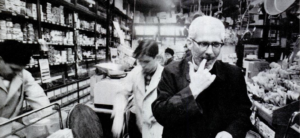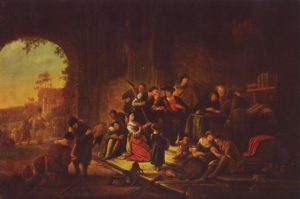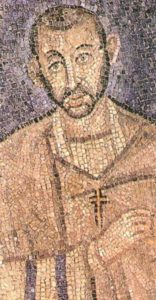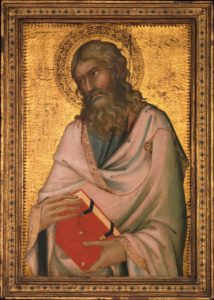 In recent weeks I have found myself thinking about the late Episcopal priest and bon vivant Father Robert Farrar Capon, whose earthly pilgrimage came to an end a decade ago this month. As a callow undergraduate I was introduced to his writings by a Lutheran pastor I knew. Those books – and the remarkable man who produced them – captured my imagination on levels theological, liturgical, musical, gastronomic, and otherwise. I sought out and savored all that I could find. I was a young man of Roman Catholic background studying philosophy at a famously conservative Presbyterian college in rural Pennsylvania and spending vacations back home in Southern California, on the cusp (though I didn’t yet know it) of profound struggles with faith and embodiment and the relationship between the two – struggles to which Our Lord’s Incarnation would eventually provide the sacramental key. My approach to Christianity at the time was abstract, rule-bound, and rather morbidly focused on my own shortcomings; unwittingly Jansenist, one might say. Capon was my introduction to the joys and freedoms of grace as encountered sacramentally in an irreducibly material world saturated by divine love, however troubling that world may sometimes be and however much we may ourselves fall short of what that love calls us to. Not all of Fr Robert’s writings are of equal quality, and he readily admitted that aspects of some of the earlier ones had not aged well. But wise and entertaining they remain, approached on their own terms and with this in mind.
In recent weeks I have found myself thinking about the late Episcopal priest and bon vivant Father Robert Farrar Capon, whose earthly pilgrimage came to an end a decade ago this month. As a callow undergraduate I was introduced to his writings by a Lutheran pastor I knew. Those books – and the remarkable man who produced them – captured my imagination on levels theological, liturgical, musical, gastronomic, and otherwise. I sought out and savored all that I could find. I was a young man of Roman Catholic background studying philosophy at a famously conservative Presbyterian college in rural Pennsylvania and spending vacations back home in Southern California, on the cusp (though I didn’t yet know it) of profound struggles with faith and embodiment and the relationship between the two – struggles to which Our Lord’s Incarnation would eventually provide the sacramental key. My approach to Christianity at the time was abstract, rule-bound, and rather morbidly focused on my own shortcomings; unwittingly Jansenist, one might say. Capon was my introduction to the joys and freedoms of grace as encountered sacramentally in an irreducibly material world saturated by divine love, however troubling that world may sometimes be and however much we may ourselves fall short of what that love calls us to. Not all of Fr Robert’s writings are of equal quality, and he readily admitted that aspects of some of the earlier ones had not aged well. But wise and entertaining they remain, approached on their own terms and with this in mind.
So taken was I with Fr Robert’s work that I wrote to him, asking (rather boldly, in retrospect) to visit. And he replied with an invitation to spend time with him and Valerie, his wife, at their home on Shelter Island during one of my college vacations. My sense of this visit is that it lasted a few days, but when I piece together in memory the events that transpired, I realize it can’t have been more than an over-night stay. It began with Mass celebrated by Fr Robert at Holy Trinity Episcopal Church, Greenport. He suggested that if I arrived early, I should ask for him, and I did that. I found him in the sacristy, albed, but not yet having put on the stole and chasuble. He was seated in an arm-chair, his feet on a table, morning sunlight filtering through the pipe-smoke rising from his briar – striking a classically Caponian attitude. The liturgy was celebrated simply and with dignity. His homily was exactly what one would expect, insightful and bonkers. All I remember of it is the image of Our Lord going out on a date with the Church and arriving in a hearse to pick her up. Still, to have remembered anything from an ordinary Sunday homily after more than twenty years is remarkable.
 The Capons’ hospitality was generous and gracious. He and I spent a memorable afternoon in chintz armchairs in their conservatory-like dining room eating liverwurst on crackers, drinking cheap white wine, and talking about the one subject with which Catholic theology is concerned: everything. He took me into the basement to see the harpsichord he had been building for years and to talk about Baroque music. That evening, Valerie drove me to the beach and we had a rambling conversation seated on the hood of her car, gazing out over a darkling Shelter Island Sound. After one of Robert’s favorite aperitifs (Cinzano on the rocks with a twist – cf. his Between Noon and Three), the three of us enjoyed a lively and delectable dinner, although I was so excited to be in their eccentric kitchen, watching Robert at work over the old commercial range familiar to his readers, that I remember nothing of what we ate. Then we smoked cigars and – somewhat to my surprise – watched tennis on television before retiring. Capon habitually rose very early for Morning Prayer, celebrated partly in his car and partly while running, with the readings in Hebrew or Greek, as appropriate. I had an early flight to catch. So, the next morning I bade him farewell in the dark outside their house, a kitchen towel over his shoulder, then drove off in my rented car to catch the ferry to Long Island.
The Capons’ hospitality was generous and gracious. He and I spent a memorable afternoon in chintz armchairs in their conservatory-like dining room eating liverwurst on crackers, drinking cheap white wine, and talking about the one subject with which Catholic theology is concerned: everything. He took me into the basement to see the harpsichord he had been building for years and to talk about Baroque music. That evening, Valerie drove me to the beach and we had a rambling conversation seated on the hood of her car, gazing out over a darkling Shelter Island Sound. After one of Robert’s favorite aperitifs (Cinzano on the rocks with a twist – cf. his Between Noon and Three), the three of us enjoyed a lively and delectable dinner, although I was so excited to be in their eccentric kitchen, watching Robert at work over the old commercial range familiar to his readers, that I remember nothing of what we ate. Then we smoked cigars and – somewhat to my surprise – watched tennis on television before retiring. Capon habitually rose very early for Morning Prayer, celebrated partly in his car and partly while running, with the readings in Hebrew or Greek, as appropriate. I had an early flight to catch. So, the next morning I bade him farewell in the dark outside their house, a kitchen towel over his shoulder, then drove off in my rented car to catch the ferry to Long Island.
I visited the Capons one other time during my undergraduate years, just for an afternoon. He made a splendid pasta puttanesca accompanied (he was ever the advocate of vin ordinaire) by red wine out of a jug. Valerie and I kept in touch afterwards for a while, occasionally, by e-mail and telephone. Gradually, though, we lost contact. I was thunderstruck by news of Robert’s death in 2013. I had always told myself the three of us would rekindle our acquaintance.
One day in 2018, I received a telephone call from Valerie out of the blue. By then we hadn’t spoken or written in years. It was lovely to hear her voice. We had a long chat. And she told me she was involved in having Robert’s writings re-published by Mockingbird Press. She was asking one of their friends to write a preface to each of the books, and she wanted me to do so for one of his earliest and most unusual, Exit 36. She gave me a deadline, and told me to call her when I had finished and dictate the piece to her over the phone. I was deeply touched by this request but it came at a difficult time. Illness in the family, unhappiness at work, a dip into melancholy – the sort of pile-up of wearying circumstances most of us experience now and again – made it a challenging task to complete. I finished in time and, since I had Valerie’s e-mail address, decided to send her the finished product that way, rather than ringing her up. Strange to say, at the time I just didn’t feel up to a telephone conversation, dear as she was to me. I suppose I feared that she wouldn’t like what I had written, and the prospect of having failed her in a task I felt so honored to perform was daunting; it must have seemed easier to me at the time to receive such news, if received it must be, by in writing. She never wrote back. I suspect she just didn’t use that e-mail address any longer and never received what I had sent. The book was published with a thoughtful preface by someone else. And I have felt ever since that I let Valerie, and Robert’s memory, down.
However, I don’t intend this to be a gloomy post! With the sense of impending transition into Autumn in the air, but Summer warmth still bathing the desert I call home, and in a Caponesque mood, I thought I would publish here, for what it’s worth, the little preface that I wrote back in 2018:
SOME THOUGHTS ON EXIT THIRTY-SIX
Father Robert approached words much as he approached food: as a necessity of human life that happened to be an outlet for his effervescent creativity and a source of great and contagious delight. But just as, when it came to food, he advocated both feast and fast, so also he understood the necessity of silence before the limits of the utterable. This book is about those limits. When confronted by an event as much on the threshold of human experience as death is, especially death by one’s own hand, or when aware that one is standing in the presence of God, the only really adequate act of speaking is to remain silent. But both before and after silence there is a human need to say something, to speak a few words into the void or toward the Mystery and see what kind of echo they might return. When we talk about the deepest levels of human experience, and especially when we talk about God, this is the best we can do. And if this be the case with even the most scholarly works of theology, then why not attempt to write theologically in a way that is obviously and even light-heartedly a preliminary sketch, an act of tinkering, an improvisation? Such writing was to become one of Fr Robert’s principal preoccupations and a vital if eccentric expression of his priesthood, and Exit Thirty-Six was one of his earliest experiments with it.








